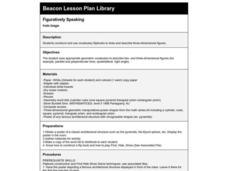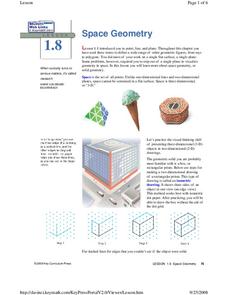Curated OER
Figuratively Speaking
Third graders construct and use vocabulary flipbooks to draw and describe three-dimensional figures. They utilize worksheets and access websites imbedded in this plan which help them construct their books.
Curated OER
Hurricane Shapes: Spatial Patterns on Satellite Images
In this earth science learning exercise, students match 21 hurricane satellite images to their appropriate shape. They also answer 4 short answer questions about hurricane shape classification.
Curated OER
Math Review
In this review of math skills instructional activity, students determine elapsed time in minutes, compare two-digit numerals, add values of money, identify an addition property and a solid figure. Students solve five problems.
Curated OER
Angles Lesson Plan
Students explore the relationship of angles as it relates to 2 and 3-D shapes. For this geometry lesson, students differentiate between acute, obtuse, right, alternate interior, exterior and adjacent angles. They manipulate a math...
Curated OER
Finding Angles, Volume, Area, and Perimeter
Elementary schoolers complete word problems dealing with the different kinds of measurements of different shapes. They solve 10 problems including perimeter, angles, volume, and more.
Curated OER
Animal Masks
Learners create wonderfully animate animal masks out of balloons. They use the papier-mache technique to create three dimensional animal masks taking care to consider color, shape, texture, and the animals' features.
CPM
Unit 3, Worksheet 1, Exponents and Algebraic Expressions
Need exponentt practice? Then this exponent activity will be helpful to have learners evaluate exponent expressions and algebraic expressions. They use the distributive property to solve equations. This three-page activity contains...
Curated OER
Perimeter of Polygons in Word Problems
Peruse these perimeter word problems with beginning geometers, possibly projecting it as an all-class warm up. There are three scenarios here, each with a visual. Scholars determine the perimeter of a swimming pool, find the missing...
Utah Education Network (UEN)
Create, Classify, and Sort Quadrilaterals
Quadrilaterals can be quirky! Fourth graders use geoboards and bands to create four-sided figures. They analyze the attributes such as angle size and presence of parallel sides. As a result they learn to differentiate among...
Curated OER
"Polly"gon Pockets
Explore polygons with your elementary learners. Divide the class in 12 to configure the polygon puzzle before them. They list the attributes of each type of polygon they see, and if there's time, they jump on the interactive website...
Arcademics
Kangaroo Hop
Scholars play against three other participants to show what they know about geometric figures. Starting at the beginning, kangaroos jump from shape to shape to match the figure to the displayed word and make their way to the finish...
Utah Education Network (UEN)
Geometry
Shape one's understanding of geometry using the resource. The sixth of seven chapters in 6th Grade Math focuses on geometry principles. Future mathematicians learn to find the area of parallelograms, trapezoids, triangles, and other...
Curated OER
Magician Squares
Elementary school learners investigate the attributes of a square. They discover that squares are polygons and examine squares found in everyday life. They concentrate on connecting the word, square, with the shape. As an...
Curated OER
Classifying Triangles Based On Properties of Angles
The interactive lesson featured here calls for the use of a Smartboard for sorting and classifying shapes. Then, pupils discuss the rules they followed for sorting their shapes, particularly focusing on the properties of angles. While...
Curated OER
Recognize and Draw Shapes Word Problems
It's time for a geometry warm up! Geometry scholars examine a figure to determine its name from a list of four choices. The figure, a trapezoid, is large enough for the whole class to see if you were to project this. An explanation at...
Curated OER
Shape & Form
Students analyze the difference between shape and form. They identify, explain and use the basic elements of design and determine that forms are three-dimensional and shapes are two-dimensional. They sketch it on their paper and then...
Curated OER
Creating Shapes
In this geometry skills lesson, students respond to 4 questions that require them to examine the pictured shapes and follow the instructions to create new shapes out of them.
Curated OER
2-D Geometry
Third graders describe and compare attributes of two-dimensional shapes. They explain geometric terms, angles and shapes. Students demonstrate each vocabulary word with their body and they mirror the body positions associated with each...
Curated OER
Using Geometric Shapes To Make Patterns
Sixth graders explore the use of shapes to create geometric patterns. they start with a simple example of dividing shapes in half to create two new ones. This can be extended to creating intricate patterns.
Curated OER
Give It a Whirl
Students examine and identify polyhedron shapes on a math website. They write journal reflections about two- and three-dimensional shapes, and transform a square into a pinwheel.
Curated OER
Finding The Area Of Shapes
Fourth graders investigate the concept of computing the area using different shapes. They use prior knowledge in order to devise a formula for a parallelogram. Scaffolding is provided by the teacher to find the formula of area for...
Curated OER
Worksheet 13: Clothes, Shapes, Parts of the Body
In this clothing words instructional activity, students analyze 5 picture clues and sentences, and for each, cross out the word that is incorrect in each set of parentheses. Each picture/sentence pair pertains to shapes or articles of...
Curated OER
Three Dimensional Figures
In this geometry worksheet, students study diagrams with labels of common geometric figures. Students then answer 24 questions. Then they draw and label their own figures.
Curated OER
Space Geometry
Students explore points, lines and planes as it relates to geometry. In this geometry lesson, students analyze space and explain wy it is 3-D and not flat or 2-D. They solve problems involving volume and 3-D shapes.























